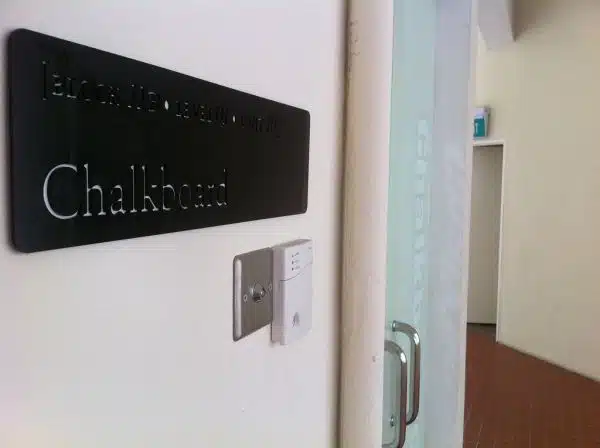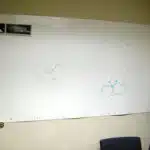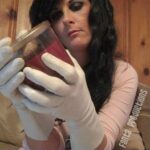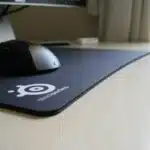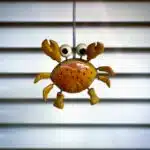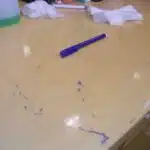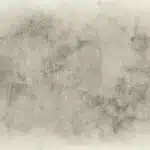Chalkboards have been an essential tool for educators and students for decades. However, after prolonged use, they can become cloudy, stained, and difficult to read. Therefore, it is crucial to clean chalkboards regularly to ensure that they remain in good condition and continue to serve their intended purpose.
As a professional chalkboard cleaning expert, I have developed a five-step process that guarantees effective cleaning of any chalkboard. This article aims to provide an easy-to-follow guide on how to clean a chalkboard in five simple steps. The steps are designed to be practical and efficient for anyone looking to maintain the longevity of their chalkboard while ensuring its readability. Whether you are an educator or student, this guide will equip you with the knowledge and skills necessary for proper chalkboard maintenance.
Gathering Necessary Materials
As a professional chalkboard cleaning expert, I understand the importance of maintaining a clean and well-maintained board. Whether you are a teacher or an artist, a clean chalkboard is essential for effective communication and presentation. To start the process of cleaning your chalkboard, it is important to gather all necessary materials. This includes DIY cleaning solutions and eco-friendly materials that will not harm the environment or damage the board.
When it comes to choosing the right cleaning solution for your chalkboard, there are plenty of options available in the market. However, using natural and eco-friendly materials can be more beneficial in terms of effectiveness and sustainability. Some popular DIY cleaning solutions include vinegar and water mixtures, baking soda paste, and lemon juice with salt. These natural solutions not only clean effectively but also eliminate harsh chemicals that may harm the environment.
Along with the cleaning solution, you will need some essential tools such as microfiber cloths or erasers to wipe off any dirt or dust from the board’s surface. It’s crucial to ensure that these cloths or erasers are soft and gentle enough to avoid scratching or damaging the surface of your chalkboard. With these materials ready at hand, you can proceed towards preparing your chalkboard for an effective cleaning session.
Preparing The Chalkboard
After gathering all the necessary materials, it’s time to start preparing the chalkboard for cleaning. Before you begin, be sure to remove all decorations and accessories from the board. Decorating chalkboards with various items can make them look appealing, but it can also make cleaning more difficult. If there are any stubborn marks or stains on the board, try removing them with a damp cloth before proceeding.
Next, you’ll want to consider some chalkboard paint tips. Some types of chalkboard paint may require special care when cleaning to avoid damage or discoloration. When purchasing a new chalkboard or repainting an existing one, be sure to research the type of paint used and follow any specific care instructions provided by the manufacturer. Additionally, avoid using abrasive cloths or harsh chemicals on painted surfaces as this can damage the finish.
Once you’ve taken these steps, you’re ready to move on to removing excess chalk dust from the board. This is an important step that should not be overlooked as it will help ensure that your board stays clean for longer periods of time. There are several methods for removing excess dust including using a soft-bristled brush or eraser. Be sure to wipe down the board thoroughly after removing excess dust to avoid spreading it around and creating more mess.
Removing Excess Chalk Dust
To ensure a clean and polished chalkboard, it is essential to remove excess chalk dust. This can be achieved through various methods, including using magnets and erasing techniques. As an expert in chalkboard cleaning, I recommend following these steps to remove excess chalk dust effectively.
Firstly, using magnets is an efficient way of removing larger pieces of chalk dust that are difficult to erase. To do this, place a strong magnet in a soft cloth or sock and gently move it over the surface of the chalkboard. The magnet will attract the metal particles found in some types of chalk and leave your board free from debris.
Secondly, when it comes to erasing techniques, there are several options available. A felt eraser is a traditional choice that works well for small areas with light dust accumulation. For more significant amounts of accumulated dust, a microfiber cloth or dry erase pad can be used. These modern alternatives not only clean your board but also prevent smudging by trapping the particles within their fibers.
In conclusion, removing excess chalk dust is vital to achieving a spotless and functional board. Using magnets and choosing the right erasing technique can make all the difference in ensuring efficient removal of debris from your board’s surface. With these tips in mind, you are now ready to proceed with the next step: applying cleaning solution for optimal results.
Applying Cleaning Solution
To effectively clean a chalkboard, you will need to apply a cleaning solution. While there are commercial options available in the market, you can also make your own DIY cleaning solution using items that you already have at home. One eco-friendly option is to mix equal parts of water and vinegar in a spray bottle. Another option is to mix 1 tablespoon of baking soda with 1 cup of warm water.
When applying the cleaning solution, it is important to not oversaturate the chalkboard surface. This can cause damage to the board and affect its lifespan. Instead, lightly mist or dab the cleaning solution onto a microfiber cloth, and then gently wipe down the surface of the chalkboard. Be sure to cover all areas of the board, paying extra attention to any stubborn stains or leftover chalk residue.
Using an eco-friendly DIY cleaning solution not only helps reduce chemical exposure but also saves money in the long run. Additionally, it is a sustainable option for those who care about protecting our environment. Now that you have applied the cleaning solution on your chalkboard surface, it’s time to move on to scrubbing down any remaining dirt and grime left behind by previous use.
Scrubbing The Surface
One common theory about cleaning chalkboards is that using a wet sponge eraser will leave the board with streaks and stains. However, this is not entirely true. While it is important to avoid saturating the board with water, using a damp sponge eraser can effectively remove chalk residue without leaving any unsightly marks.
When it comes to scrubbing the surface of a chalkboard, there are several key factors to consider. Choosing cleaning products that are safe for use on chalkboards is crucial, as harsh chemicals or abrasive materials can cause damage or discoloration. Additionally, it’s important to use a gentle but firm hand when scrubbing the surface in order to remove all traces of chalk without scratching the board itself.
To prevent scratches and other damage during the cleaning process, it’s important to take certain precautions. For example, always start by wiping down the board with a dry cloth or eraser before applying any cleaning solution. This will help remove loose particles of chalk and prevent them from scratching the surface during scrubbing. Additionally, be sure to use a soft-bristled brush or sponge when scrubbing the board, and avoid pressing too hard or using excessive force.
- Always choose cleaning products that are specifically formulated for use on chalkboards.
- Use a damp sponge eraser to effectively remove chalk residue without leaving streaks.
- Take care not to scratch the surface of the board by using gentle pressure and soft-bristled tools.
- Wipe down the board with a dry cloth or eraser before applying any cleaning solution.
Moving on from scrubbing the surface of your chalkboard, it’s time to focus on rinsing away any remaining residue for a perfectly clean finish.
Rinsing The Chalkboard
After scrubbing the surface of your chalkboard, it’s important to rinse off any remaining cleaning solution. This step ensures that all dirt and grime are removed from the board, leaving you with a clean slate for your next lesson or presentation. To rinse the chalkboard, simply use a clean damp cloth or sponge and wipe down the entire surface.
When selecting chalkboard cleaning products, consider using eco-friendly options. These products are not only better for the environment but also safer for you and those around you. Eco-friendly cleaning solutions do not contain harsh chemicals that can be harmful to your health and can still provide effective cleaning results.
Rinsing is an essential step in ensuring that your chalkboard is thoroughly cleaned. However, it’s equally important to dry the surface properly before using it again. In the next section, we will discuss how to effectively dry your chalkboard to ensure that it stays in good condition for years to come.
Drying The Surface
After completing the cleaning process, it is essential to dry the chalkboard thoroughly. This step ensures that there is no moisture left on the surface that may cause stains or smudging. There are two ways to dry a chalkboard: air drying and towel drying.
Air drying is the most common method of drying a chalkboard after cleaning. After wiping the surface clean, leave it to dry naturally for some time. Ensure that there are no obstructions in the way of the chalkboard, which may cause dust or debris to settle on it. The duration of air drying depends on various factors such as temperature and humidity levels in your environment.
Towel drying is another effective method of drying a chalkboard. This method involves wiping off any remaining moisture with a clean towel. Using a high-quality microfiber cloth or chamois leather will ensure that there are no residual streaks left behind. Be gentle while doing this to avoid damaging the surface of the board. It is crucial to note that using abrasive materials such as paper towels may scratch or damage the board’s surface.
Inspecting for residual stains should be done after ensuring that the chalkboard has been adequately dried using either air or towel drying methods. In some cases, stains from previous use may still be visible even after cleaning and drying. In such instances, you can use specialized cleaning agents like vinegar or a mixture of baking soda and water to remove them completely. However, be careful not to oversaturate the board with these solutions as they may leave behind unwanted residues when not used appropriately.
Inspecting For Residual Stains
After drying the chalkboard, it is important to inspect the surface for any residual stains. This step is crucial as it helps determine the effectiveness of the cleaning process. It also allows for the identification of any stubborn stains that may require further treatment.
To check for effectiveness, stand at a distance from the chalkboard and examine it under good lighting. Look for any areas where chalk residue or smudges are still visible. If there are any remaining marks, repeat the cleaning process using a different cleaning agent. For example, if water and soap were used initially, try using vinegar or rubbing alcohol to remove stubborn marks.
In case there are still some stains left after using different cleaning agents, it is time to move on to treating stubborn stains. These can be caused by permanent markers or other materials that have been left on the surface for too long. In the next section, we will explore effective ways of removing these stubborn stains without damaging your chalkboard surface.
Treating Stubborn Stains
Did you know that in a study conducted by the National Safety Council, it was found that slips and falls account for nearly 9 million emergency room visits each year? This highlights the importance of keeping your chalkboard clean and free from any potential hazards. However, sometimes stubborn stains can be difficult to remove even with regular cleaning methods.
If you are faced with an ink stain on your chalkboard, don’t worry! There are some tips and tricks you can use to help remove it. One effective method is to create a vinegar solution by mixing equal parts of white vinegar and water. Dip a soft cloth into the solution and gently rub the stained area. Be sure to rinse with water afterward and dry thoroughly.
For more stubborn ink stains, try using a magic eraser or rubbing alcohol. Simply apply the product onto the stain and gently rub until the stain disappears. However, be cautious when using these methods as they may also remove some of the chalkboard’s finish or paint.
Using these tips for removing ink stains from chalkboards will help keep your board looking clean and new. If these methods do not work, there are alternative cleaning methods that can be used as well. In the following section, we will explore some additional cleaning techniques that may better suit your needs.
Using Alternative Cleaning Methods
As a professional chalkboard cleaning expert, I understand that traditional methods for cleaning chalkboards may not always be the most effective or eco-friendly. Luckily, there are alternative cleaning methods that can provide similar results while also being kinder to the environment. One of the best options is using homemade cleaning solutions.
Homemade cleaning solutions are an excellent choice for those who want to use eco-friendly options and save money. To make a simple solution at home, mix equal parts water and vinegar in a spray bottle. This mixture can effectively remove chalk residue and leave your board looking clean and shiny. Another option is using baking soda mixed with water to create a paste that can be applied directly onto the board for tougher stains.
Another alternative cleaning method is using eco-friendly options like microfiber cloths or eraser sponges. These materials are gentle on your board and don’t require any harsh chemicals or solvents to achieve maximum cleanliness. Additionally, using these materials reduces waste by eliminating the need for disposable wipes or paper towels.
Overall, exploring alternative cleaning methods like homemade solutions and eco-friendly options can help you achieve a cleaner, greener chalkboard without breaking the bank or harming the environment. In the next section, we’ll explore how to maintain your newly cleaned chalkboard to ensure it stays looking its best over time.
Maintaining The Chalkboard
After cleaning your chalkboard thoroughly, you need to maintain it so that it remains in good condition. Here are some cleaning techniques that will help you maintain your chalkboard:
Firstly, use a soft cloth or eraser to remove dust and debris from the board. This is important because leaving dust on the board can cause scratches and damage the surface. Use a damp cloth to wipe away any stubborn marks or stains that are left behind.
Secondly, do not use any harsh chemicals or abrasive materials when cleaning the board. These can cause permanent damage to the surface of the board, making it difficult to write on in the future. Instead, use mild soap and water to clean your chalkboard regularly.
Lastly, make sure you store your chalk and erasers properly. Keep them in a dry place where they won’t be exposed to humidity or moisture as this can cause them to deteriorate quickly. By following these maintenance tips, you can ensure that your chalkboard stays clean and in good condition for years to come.
Moving forward into preventing future damage, there are additional steps that you can take to ensure that your chalkboard remains in top shape. By taking preventative measures such as using a quality chalkboard cleaner and avoiding exposure to extreme temperatures, you can protect your investment and extend its lifespan even further.
Preventing Future Damage
Now that you have learned how to clean a chalkboard effectively, it’s time to focus on preventing future damage. One of the most common issues with chalkboards is smudging. Smudging occurs when the chalk dust settles on the surface and gets smudged around as you write or erase. To prevent smudging, use a microfiber cloth to wipe down the board after each use. This will help remove any residual chalk dust and keep your board looking clean and fresh.
Another way to prevent damage is by cleaning without chemicals. While some commercial cleaning products may seem like a quick and easy solution, they can actually do more harm than good in the long run. Chemicals can strip away the protective coating on your board and cause it to become scratched or damaged over time. Instead, opt for natural cleaning solutions such as vinegar and water or baking soda and water. These solutions are gentle yet effective at removing dirt and grime from your board without causing any damage.
Finally, make sure to store your chalkboard erasers properly. Erasers can pick up dirt, dust, and other debris over time, which can transfer onto your board when used. To avoid this issue, store your erasers in a dry place and consider using a sealable container to keep them clean between uses.
With these preventative measures in mind, you can keep your chalkboard looking great for years to come! In the next section, we will cover step-by-step instructions on how to clean your chalkboard erasers effectively.
Cleaning Chalkboard Erasers
Metaphorically speaking, a chalkboard eraser is like a soldier on the front line of battle, taking on the daily assault of dust and chalk particles. With continuous use, it becomes covered in debris and loses its ability to clean effectively. As a result, it is essential to maintain cleaning techniques that will keep your erasers in top condition.
When it comes to cleaning chalkboard erasers, you have two options: purchase new ones or make your own DIY erasers. The latter option can be cost-effective and easy to do with materials such as felt, foam or even old towels. A great tip is to add a few drops of lemon juice before washing to help remove any stains or discoloration.
Cleaning technique is critical when maintaining the longevity of your chalkboard erasers. One helpful method is to tap the eraser against a hard surface until all loose debris falls out. Afterward, use warm water and mild soap to wash thoroughly before air-drying overnight. If the eraser has stubborn stains or marks, try using a soft-bristled brush with some baking soda for a deeper clean.
Effective cleaning techniques for your chalkboard erasers are crucial in maintaining their functionality and prolonging their lifespan. DIY options are not only cost-effective but also environmentally friendly by repurposing old materials. In the next section, we’ll discuss how proper storage methods can ensure that your chalkboards remain in pristine condition for years to come.
Storing Chalkboards Properly
Proper Storage and Handling Techniques for Chalkboards
Storing chalkboards properly is essential to maintain their longevity and prevent damage. Improper storage can lead to scratches, dents, and even cracks on the surface of the board. To prevent such damage from occurring, it is important to consider various factors such as temperature, humidity levels, and handling techniques.
One effective way to store your chalkboard is by placing it in a dry room with consistent temperature and humidity levels. Avoid storing your board in damp or humid areas as this can cause the board to warp or swell. It is also recommended to store the board vertically rather than horizontally as this will prevent any unnecessary pressure on the surface of the board.
When handling your chalkboard, it’s important to use both hands while lifting or moving it. Avoid dragging or sliding the board against surfaces as this may result in scratches or dents on the surface. Additionally, never place heavy objects on top of the board as this may cause irreparable damage.
| Proper Storage | Handling Techniques |
|---|---|
| Place in a dry room with consistent temperature | Use both hands when lifting/moving |
| Store vertically | Avoid dragging/sliding against surfaces |
| Avoid damp/humid areas | Do not place heavy objects on top |
In summary, proper storage and handling techniques are crucial for maintaining your chalkboard’s quality and longevity. Always ensure that you store your chalkboard in a dry area with consistent temperature and humidity levels while using both hands when handling it. By following these guidelines, you’ll have a clean and long-lasting chalkboard that you can use for years to come.
Moving forward into troubleshooting common issues with chalkboards…
Troubleshooting Common Issues
Like every other cleaning task, chalkboard cleaning is not without its challenges. However, with the right approach and knowledge, you can troubleshoot common issues that may arise while cleaning your chalkboard. In this section, we will discuss some of the common problems you may encounter during chalkboard cleaning and how to deal with them effectively.
Firstly, preventing smudging is essential to maintaining a clean and presentable chalkboard. Smudging occurs when the chalk residue mixes with water or any liquid during cleaning. To prevent smudging, ensure that your chalkboard is dry before you start cleaning it. Also, use a microfiber cloth to wipe off the excess chalk dust before using water. This will help to reduce the likelihood of smudging and make your cleaning process more effective.
Secondly, dealing with ghosting can be quite challenging for many people who clean their chalkboards regularly. Ghosting refers to faint marks left on the board even after it has been cleaned. One way to deal with ghosting is by using a white vinegar solution. Simply mix equal parts of white vinegar and water in a spray bottle and apply it directly onto the board. Leave it for about five minutes before wiping it off with a microfiber cloth or eraser. This will help to remove any remaining residue on the board.
Lastly, ensuring that your chalkboard stays clean for longer periods requires proper maintenance techniques such as regular dusting and avoiding using abrasive materials during cleaning. Using soft-bristled brushes or slightly damp cloths during dusting helps remove all traces of residue on the board without damaging its surface.
In conclusion, maintaining a clean and presentable chalkboard requires consistent effort and attention to detail. Preventing smudging through proper drying techniques and dealing with ghosting through vinegar solutions are essential steps towards achieving this goal. By following these simple tips and taking good care of your board, you can enjoy a long-lasting clean surface perfect for writing or drawing.
Conclusion
As a professional chalkboard cleaning expert, it is important to know the necessary steps to properly clean and maintain your chalkboard. By following these simple steps, you can ensure that your chalkboard remains in good condition and free of excess dust and dirt.
After gathering the necessary materials, it is important to prepare the chalkboard by removing any excess chalk dust. Once the surface has been prepared, apply a cleaning solution and scrub the surface thoroughly. Additionally, be sure to take preventative measures to avoid future damage and properly store your chalkboards.
Remember that maintaining a clean and well-maintained chalkboard not only supports an effective learning environment but also extends its lifespan. As a result, ask yourself: how much time would you save if you had a clean slate every day? Taking care of your chalkboards can ultimately make for a more efficient classroom environment while also saving on replacement costs.
Image Credits
- “chalkboard” by jonrussell (featured)

